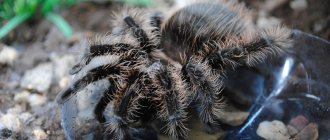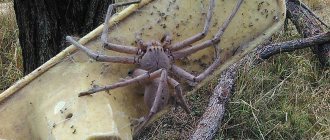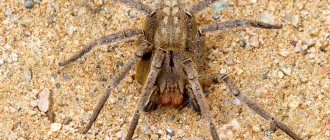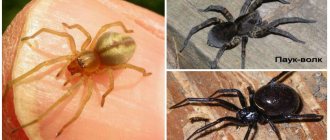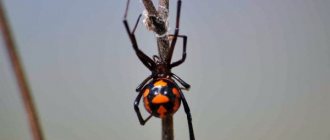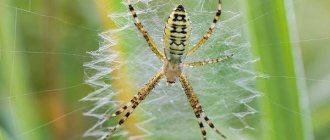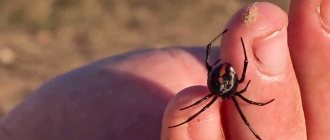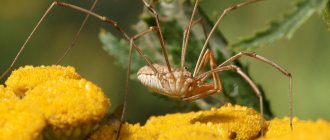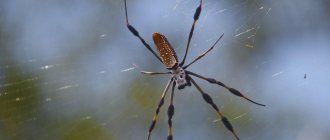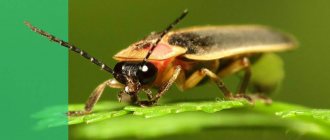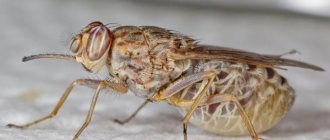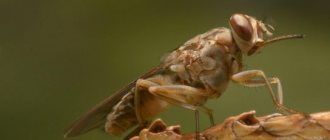The cross spider is a representative of the most common species, which is found in almost all regions except northern and southern latitudes. It prefers places with high humidity and is most often found in gardens, fields, among shrubs growing near water bodies, as well as in groves and forests. It can also live on the eaves of buildings and on the facades of buildings.
General information
How long the cross spider lives and what it looks like depends on its type:
- An ordinary cross. This is the most common of all spiders with a cross on its back. The size of females reaches 2.0-2.5 cm in length, and males - 1.1 cm. In addition, males have a narrower body. In both sexes, the body is covered with a waxy substance that retains water. The cephalothorax is protected by a reliable shell.
- Spider with a red cross. This species is characterized by small body size. Their color differs depending on the lighting. On the back there is a pattern resembling a red cross. Other body features do not differ from a regular cross.
- Barn spider. Females and males of this species of arthropod are approximately the same size. Females reach 1.3-2.2 cm in length, and males - 1.0-2.0 cm. This is a yellow spider, the center of its abdomen is represented by uneven brown notches. A dark stripe with two dazzling white spots runs along the lower part of the body.
- Meadow cross. Mainly lives where there is moisture and a lot of grass. The cross on it is dark or light in color. A blurry pattern resembling a leaf is visualized at the bottom. The body has a light green or brown tint. Light stripes are visible on the paws. The body length of a female is 1.7 cm, and that of a male is 0.8 cm. Females blend into their environment, changing their color, like chameleons.
- Marble cross. This species is characterized by pronounced sexual dimorphism. Females are significantly larger than males in size. Their length reaches 1.8 cm, males - up to 0.8 cm. These arthropods have a variety of shades and patterns. But most often they have an orange belly and a black pattern. This combination of colors served as the choice for the name of the species.
A pure black spider with a white cross on its back is just a work of human imagination. There are no representatives of this arthropod species with this color. The life cycle of different species of this arthropod varies within 1-2 years.
Is the cross spider dangerous for humans?
The cross spider is poisonous. When biting insects or humans, it readily releases a toxic substance. Most often this occurs when the crusader comes into direct contact with a person’s hand.
The bite of the cross spider is not fatal to people, but after the incident the following symptoms develop:
- slight disturbance of spatial orientation;
- cephalgia;
- feeling of general weakness;
- aching joints;
- soreness throughout the body;
- the bite site itches, tingles, turns red;
- small hematomas appear.
Although the spider's venom does not cause death, first aid should not be neglected. After a bite, it is useful to do the following:
- Wash the pathological lesion with soap and water to avoid additional infection.
- Apply ice or any cold object to the bitten area.
- If you have a fever or headache, take an NSAID or antipyretic.
- A person prone to allergies should take an antihistamine to prevent the development of unwanted reactions in the body.
If a child is bitten by a cross spider, he should be taken to the hospital and shown to a doctor. To avoid being bitten by an arthropod, it is important to adhere to the following rules:
- When camping in the forest with tents, it is important to cover your sleeping area well at night and use a mosquito net.
- Before going to bed outdoors or in the morning, you need to carefully inspect your sleeping place, clothes and shoes for the presence of spiders or various insects.
- A great danger can be posed by cobwebs along the way. It is better not to come into contact with it, since female spiders sit on it, waiting for a new victim.
- Arriving at a camp site or an old, uninhabited house, you should inspect all the cracks. It is also important to ensure that these arthropods do not weave their webs in dacha gardens.
When faced with a cross spider, under no circumstances should you pick it up. It is also important to teach this to your children in advance.
Benefits for humans
People actively use the web of crosses. It is ideal for sighters of various optical instruments: microscopes, telescopic sights. And microbiologists, with its help, invented an innovative air analyzer.
The crosser is placed on a special frame, fed, and he weaves his net on its basis. Then a portion of air is passed through this frame, and the thinnest web traps pathogenic microorganisms that fill the air space. This method of air analysis has been recognized as the most effective of all existing in the world.
Folk healers have long used spider webs to disinfect open wounds. Over time, medical research has confirmed that spider webs actually kill pathogenic bacteria. Based on it, drugs were developed that are harmless to animals, but destructive to all kinds of bacteria.
What do amazing insects eat?
This species is a carnivore. For food they need aphids, flies, mosquitoes, and midges. Spiders wait for their potential prey in the middle of the web , to which a signaling thread is attached.
As soon as an insect flies up to the web and gets into it, then trying to get out, they create vibration in the web, thus the cross in the center receives a signal about a potential victim. Considering that the legs of cross spiders have olfactory organs, they can also hear the prey with their legs. After receiving a signal, the insect approaches the victim and, with the help of a bite, injects poison into the body - chelicerum. Some krestoviki immediately eat the victim, while others leave food in reserve . They wrap the victim in a web and hide it from prying eyes in the foliage.
These insects eat a lot. During the day they need an amount of food equal to their own weight. The cross spider is almost always on duty, hunting. During the day, he devotes only a small amount of time to rest , while the signal thread remains tied to his leg.
Cross spiders will not eat insects that are too large for them or poisonous. They throw such people out of the web, cutting it off. Dangerous to these creatures are wasps and flies, which leave their larvae on the body of another animal. If such a fly or wasp leaves its larvae on the spider, then they themselves will begin to eat it and develop.
Spider structure
The size of cross spiders depends on gender. On average, the male reaches up to 1.0 cm, and the female up to 2.0 cm. In some species, the length of female specimens reaches 2.6 cm. Arachnologists study the body parts of the cross spider with great interest.
External
The number of legs intended for walking in the cross spider is 8 pieces. In addition, it has 1 pair of pedipalps, which are responsible for recognizing and holding the victim. And also 1 pair of chelicerae (jaws). The spider uses them to attack and kill its prey. The oral appendages of arthropods point downward, and their hooks point inward.
The eyes (4 pairs) of the arthropod do not serve their purpose well. They allow you to see only blurry silhouettes, a flash of light or a shadow. But this disadvantage is compensated by a well-developed sense of touch. The entire surface of the spiders' body is covered with a large number of tactile hairs. They perceive chemical and sound stimuli, and also react to air currents.
The posterior part of the body is rounded and not divided into segments. On its lower part there are 3 pairs of warts with a large number of glands. They are necessary for the cross to produce a variety of threads that help it in various situations. With their help, they weave webs, make cocoons or arrange shelters.
Internal
The internal structure of the spider is also of great interest. Not all of his organs are located on his abdomen.
Digestion
Crosses have external digestion. They are unable to swallow whole food and then digest it. They are forced to build nets to catch prey. When the prey is in the web, the spider injects it with a special juice necessary for fermentation, wraps it in a cocoon, and then waits for the prey to digest and become a nutrient solution that the arthropod drinks.
Respiratory system
The spider's abdomen contains organs of the respiratory system. They are a pair of pulmonary sacs with a large number of leaf-like folds, as well as 2 bundles of tracheal tubes. They are filled with air and hemolymph (a biological fluid similar to blood that fills the spider’s vessels) flows through them to enrich them with oxygen.
The cardiovascular system
The Crusaders have an open circulatory system. The dorsal part of the abdomen contains the heart. Its appearance resembles a long tube with large blood vessels branching off. The anterior aorta, which branches into arteries, is connected to the anterior end of the heart.
From the terminal arterial branches, hemolymph enters the body of the crusader spider. While washing the internal organs, it supplies them with oxygen and nutrients. Gas exchange occurs when hemolymph flows through the pulmonary sacs. The hemolymph contains a blue pigment that contains copper.
Excretory system
In the cross spider, the excretory system is represented by coxal glands and malpighian vessels in the form of tubes. The latter are circular protrusions of the intestinal wall. They are localized between the midgut and hindgut, and allow waste products to be absorbed from the body cavity of the arthropod.
The coxal glands, in the form of two sacs, are located on the fused head and thoracic segments. They diverge into a system of canals that end in excretory ducts at the base of the legs intended for walking.
Appearance of an insect
Because of the peculiar cross on the back, the spider got its name - cross. The cross itself is formed from white and light brown spots. The creature's abdomen is round and brown. There are 4 pairs of legs on the body, which are hypersensitive, and 4 pairs of eyes, directed in different directions. The insect's eyes allow it to view the world around it from all sides. An interesting detail: spiders have blurred vision; they only see the outlines of objects or their shadows .
Females are almost twice as large as males. For comparison: the size of females varies between 17-26 centimeters, and males - 10-11 cm. After certain periods, cross spiders molt and shed their chitinous cover. This period is characterized by active growth.
Insects are especially active at night; during the day they hide in their shelters. At night they weave webs. During the day, females can also become more active . This could be hunting flies and butterflies. The unique creature freezes in one position, which at first glance gives the impression that he is dead, but this is a trick for the victim.
Range and habitats
Crossworts are found throughout the globe in temperate or tropical climates. Some species of such arthropods live in Europe, Asia, Africa, and also in North America. In their first year, spiders overwinter in the egg stage.
The habitat of the cross spider is damp, low-lying places, in the vicinity of which there are bodies of water. They also like forests, parks or gardens, where it is convenient to weave catching nets between the branches.
Sometimes a round web of crosses is found in window and door openings, as well as under the roofs of abandoned buildings.
Features of reproduction
In spiders, reproduction is accomplished by mating. By the end of the mating period, the male loses his life. And the fertilized female begins to weave a cocoon for eggs, which she usually lays with the onset of autumn.
At first, the female wears the cocoon on herself, and then throws it off in a secluded place (a gap in the bark of trees or in non-residential buildings). With the arrival of spring, young (juvenile) spiders crawl out of the cocoon. They become sexually mature towards the end of summer. And the female, who took care of their birth, dies by that time.
Cross spider: male and female
Diet
The diet of the crusader spider consists of various insects such as flies, wasps, hornets, grasshoppers, locusts, caterpillars, butterflies, etc. Snakes, mice, frogs, etc. get entangled in large webs woven from strong threads.
The spider does not have an internal digestive system, so it consumes liquefied food. After a spider bite, when the spider injects a portion of poison, the victim is immobilized. At the same moment, he injects a special secretion into the victim, which turns solid tissue into a liquid mass. After about 20 minutes maximum, the spider starts eating.
What does the cross spider eat?
The cross spider has a varied diet:
- fruit flies;
- any dipterous insects;
- wasps, bees, ants;
- grasshoppers;
- aphidids;
- other small insects.
To get its food, the cross is forced to build a web to catch prey. When a victim falls into the net, the spiders do not eat the food immediately, but wrap it in a cocoon and hide it. This is necessary so that the fermentation process takes place, and also so that other relatives do not covet the prey.
Behavior in the wild
Arachnids of the orbweaver family are carnivorous. They settle on the crowns of trees, in the branches, where they set up trapping nets that catch small insects. Leaves are used as shelter.
Under natural conditions, the predator's web is smaller than in captivity. Every day or two, the crossers destroy the woven network and make a new one. The “construction” of a new trap is carried out at night, so that prey can be caught in the morning. This daily activity is due to the fact that in the dark there are fewer enemies, insectivorous birds sleep, and you can “work” calmly.
Interesting Facts
A spider with a cross has the following features:
- The web of the cross is of great interest. It is elastic and has high strength. Since ancient times it has been used to make fabrics or decorations. People from tropical countries weave nets and nets from it to catch fish.
- Microbiologists have also not ignored the spider web. They use it to determine the composition of atmospheric air, as well as to produce the thinnest optical fiber.
- Interestingly, spiders move freely through their trapping webs and do not stick to them. This is explained by the fact that they move along radial, dry threads.
Crossmen are unique creatures. They can be very useful for a person. But if, due to an unfortunate combination of circumstances, the arthropod still bites, then first aid measures should be taken. But there is no reason to seriously fear for your health after this.
